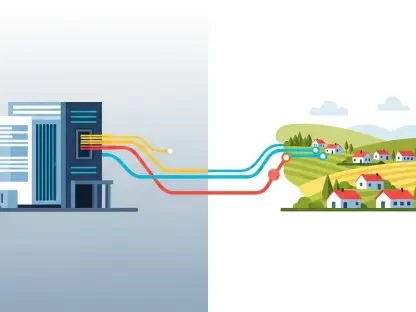Diving into the dynamic world of telecommunications, I’m thrilled to sit down with Vladislav Zaimov, a seasoned expert in enterprise telecommunications and risk management of vulnerable networks. With years of experience navigating the complexities of fiber optic infrastructure, Vladislav offers unparalleled insights into the evolving fiber market, especially as it faces significant consolidation and competitive pressures. In this conversation, we’ll explore the latest trends in mergers and acquisitions, the differing perspectives of operators and investors on industry challenges, the impact of emerging technologies like fixed wireless access, and the future of fiber deployment opportunities.
How do recent surveys reflect the anticipated trends in mergers and acquisitions within the fiber market over the coming year?
Recent surveys, like the one from AlixPartners, paint a clear picture of a market gearing up for significant change. About 80% of respondents expect a surge in M&A activity over the next 12 months, with a focus on companies that have fewer than 500,000 fiber passings. This suggests that smaller and mid-tier players are prime targets for consolidation as larger operators look to scale up. Additionally, 61% of those surveyed plan to actively participate in these deals, which shows a strong intent across the board to either grow through acquisitions or exit the market entirely. It’s a natural evolution for an industry at this stage, where efficiency and scale are becoming critical to survival.
What’s driving this high expectation for increased M&A activity in the fiber sector?
Several factors are at play here. First, the fiber market is reaching a point of saturation in terms of new deployment opportunities. There are fewer profitable areas to build out, so companies are looking to acquire existing networks to expand their footprint. Second, the competitive landscape is intensifying with pressures from cable and fixed wireless access, pushing operators to consolidate to strengthen their market position. Finally, the need for operational efficiency and cost reduction is a huge driver—merging with or acquiring other players allows companies to streamline operations and create value in a crowded space.
There seems to be a notable divide between fiber operators and investors when it comes to industry challenges. Can you break down the key differences in their concerns?
Absolutely, the disconnect is quite striking. Investors often focus on operational hurdles, with 44% citing construction complexity as a major issue, whereas only 20% of operators share that concern. On the other hand, operators are far more worried about business model sustainability—47% point to competitive pressures from fixed wireless access and cable, and a whopping 64% are anxious about declining average revenue per user, or ARPU. Investors seem less troubled by these revenue and competition issues, which is puzzling given the consolidation wave we’re seeing. It highlights a gap in how each group perceives the immediate risks and long-term viability of fiber investments.
Why do you think operators are so much more focused on competitive pressures compared to investors?
Operators are on the front lines, deeply embedded in their markets. They see firsthand how technologies like fixed wireless access and cable are eating into their customer base. For them, competition isn’t just a concept—it’s a daily reality affecting subscriber numbers and revenue. Investors, while strategic, often look at broader financial metrics and may underestimate the ground-level impact of these alternatives. Operators understand that if they can’t differentiate their services or maintain competitive pricing, they risk losing market share rapidly, which is why nearly half of them see this as a top threat.
How is the rapid growth of fixed wireless access, with telcos adding millions of customers annually, affecting fiber operators?
The growth of fixed wireless access, or FWA, is a real game-changer. Telcos like the major players in the U.S. are adding 3 to 4 million FWA customers each year, building a base of over 13 million in just five years. This is a direct challenge to fiber operators because FWA offers a quicker, often cheaper alternative to wired broadband, especially in areas where fiber rollout is slow or costly. For fiber operators, this means not just losing potential customers but also facing pressure on pricing and ARPU. It’s forcing them to rethink their strategies—whether to accelerate buildouts, enhance service offerings, or even partner with wireless providers to stay relevant.
With fewer opportunities for new fiber deployments, what challenges are operators facing in terms of expansion?
The challenge is pretty straightforward but daunting—there are simply fewer places left where fiber operators can deploy new networks and expect high penetration rates. Many of the low-hanging fruit, so to speak, have already been picked. Urban areas are often saturated, and rural areas can be unprofitable due to low population density and high construction costs. This scarcity of viable new markets is pushing operators to focus on existing assets, optimize their networks, or look for acquisition targets rather than greenfield builds. It’s a sign that the industry is maturing, but it also means growth through expansion is becoming much harder.
Looking ahead, what is your forecast for the future of the fiber market in light of these consolidation trends and competitive pressures?
I think we’re in for a transformative couple of years. Consolidation will likely peak over the next 24 months, with larger operators absorbing smaller ones to build scale and efficiency. We’ll see a lot of deals targeting mid-tier players, especially those with under 500,000 passings, as they’re the sweet spot for growth through acquisition. At the same time, competition from fixed wireless and cable isn’t going away—it’ll push fiber operators to innovate, whether through bundled services, better customer experiences, or cost efficiencies. Long-term, I expect the market to stabilize with fewer, larger players dominating, but only those who adapt to these competitive and geographic challenges will thrive.









